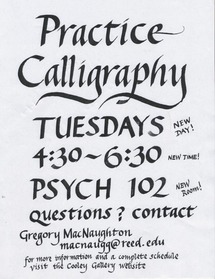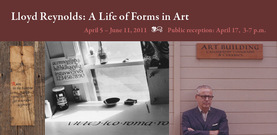
IRIS login | Reed College home Volume 96, No. 2: June 2017
Tags
"Cooley Gallery"
Jamie Isenstein ’98: The Lady Returns
Jamie Isenstein ’98, last seen on campus in 2011, inhabiting an armchair (The Lady Vanishes) returns to the Cooley Gallery for a public reception, beginning at 6 p.m. on Thursday, September 19, 2013. This mid-career survey is curated by gallery director Stephanie Snyder ’91, who admires Jamie's drawings, mixed-media sculptures, and installations as pieces that "engage the artist’s body as an artistic medium—a subject of humor, theatricality, and historical representation." A studio art major at Reed, Jamie became intrigued with Northern Renaissance art and considers her own work to be an update on many of the themes popular then, such as the Vanitas and Momento Mori. At Art Basel in 2011, she staged an "anti-concert" in which she spent two weeks weaving a rug onto a harp, compromising its strings and thereby removing music (dampening sound) vs. making music (video). You can see her at her harp once again on Thursday evening.
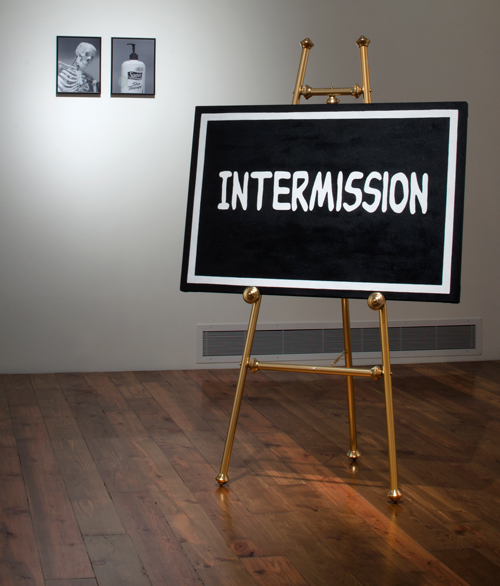 In an essay for the catalog of the exhibition, Jamie Isenstein: Will Return, Graham Jones ’97, MIT anthropologist and an expert on the subculture of entertainment magic, suggests that the magician's craft relies upon an audience that is aware of the deception and desiring of it. He has great appreciation for the ways in which Jamie uses her half-hidden body to evoke curiosity and desire; she is gently teasing her audience with the deferred possibility of interaction, which is in itself the physical manifestation of her "intermission" and "will return" conceits. Just as she provokes a kind of awe when confined to motionless poses, we are forced to pause and consider new ways of perceiving art in spite of our own constraints.
In an essay for the catalog of the exhibition, Jamie Isenstein: Will Return, Graham Jones ’97, MIT anthropologist and an expert on the subculture of entertainment magic, suggests that the magician's craft relies upon an audience that is aware of the deception and desiring of it. He has great appreciation for the ways in which Jamie uses her half-hidden body to evoke curiosity and desire; she is gently teasing her audience with the deferred possibility of interaction, which is in itself the physical manifestation of her "intermission" and "will return" conceits. Just as she provokes a kind of awe when confined to motionless poses, we are forced to pause and consider new ways of perceiving art in spite of our own constraints.
Continue reading Jamie Isenstein ’98: The Lady Returns
Calligraphy Returns!
One of the most exciting developments at Reed this fall is the return of calligraphy. As alumni know, calligraphy has a long and distinguished history at our college. From 1939 to 1984, Reed's humanist calligraphy program, under the direction of Lloyd Reynolds and Robert Palladino, inspired countless Reed students who pursued distinguished careers in the visual arts, typography, design, and literature, including luminaries like Steve Jobs and typeface designer (and Macarthur genius grant winner) Charles Bigelow '67.
The new Reed Scriptorium is part of the Cooley Gallery's new Calligraphy Initiative (the brainchild of Stephanie Snyder '91) and was developed and is coordinated by Gregory MacNaughton '89. Stephanie and Greg have both shown immense leadership in bringing this vital program back to the college. I dropped by the scriptorium the other night and it was packed with current students, staff, faculty, and old Reedies alike. Take a look at the Cooley's beautiful calligraphy Tumblr for more information about the program.
Continue reading Calligraphy Returns!
Kara Walker's Long Shadows
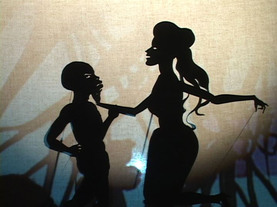 The sign outside the Cooley Gallery warns of explicit content — leading some visitors to believe they are in for something provocative. While there can be no doubt that Kara Walker's art can shock, what it provokes are conversations.
The sign outside the Cooley Gallery warns of explicit content — leading some visitors to believe they are in for something provocative. While there can be no doubt that Kara Walker's art can shock, what it provokes are conversations.
"Kara is giving us permission to start and continue a conversation about otherness," says Stephanie Snyder '91, the John and Anne Hauberg Curator and Director of the Douglas F. Cooley Memorial Art Gallery in the Reed library.
On display at the gallery through November 18, Kara Walker More & Less sets the stage for a lecture the acclaimed artist will deliver on campus on October 2 as a Stephen E. Ostrow Distinguished Visitor.
Continue reading Kara Walker's Long Shadows
A Five-Octave Finale
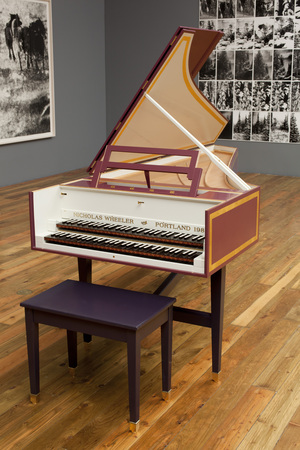 The Douglas F. Cooley Memorial Art Gallery was packed to the rafters last week as alumni from many eras came together in a hush of anticipation to witness a unique occasion--the unveiling of the French double harpsichord created by professor Nicholas Wheeler '55 [physics 1963-2010] over a span of 26 years, and showcased during Reunions '12: Reedfayre.
The Douglas F. Cooley Memorial Art Gallery was packed to the rafters last week as alumni from many eras came together in a hush of anticipation to witness a unique occasion--the unveiling of the French double harpsichord created by professor Nicholas Wheeler '55 [physics 1963-2010] over a span of 26 years, and showcased during Reunions '12: Reedfayre.
Nick became fascinated by the harpsichord (the distinguished ancestor of the piano) while playing at a concert his freshman year at Reed and resolved to build his own some day. He finally began work many years later, in August 1985, when he was A.A Knowlton Professor of Physics. While the bulk of the carpentry and metalwork were completed in the two years that followed, the venture languished for two decades when his teaching and other things took greater precedence. Nick was not able to put finishing touches on the instrument until after his retirement in 2010, after 47 years of service.
"This is a Reed instrument and its first public appearance. It's something I've fantasized about for 60 years," Nick remarked. Returning students and friends continued to ask over the years when and if the project would ever be finished. "It is a doubt which I confess, I sometimes shared: it gave me anxiety because I did not want to leave to my heirs the problem of figuring out how to dispose of a stringless box that looked like a harpsichord, but was unplayable." However friends, such as professor Kathleen Worley, [theatre 1985-] helped along the way by picking up some gold-dipped hardware and wood scrapers.
Continue reading A Five-Octave Finale
Calligraphy Leaps off the Page
The greatly anticipated exhibition, Lloyd Reynolds: A Life of Forms in Art, has begun its run in the Cooley Art Gallery. Just hours after it opened, Robin Tovey '97 and I convened at the Hauser Library and headed to the gallery. An arresting exhibition poster hangs just outside, featuring an enlargement of Lloyd's piece "Calligraphy for People." It's a powerful piece--the words connect to one another through serpentine pen strokes--and aptly chosen. Lloyd, who was passionate about teaching, made this "beautiful writing" accessible to people in all walks of life, just as he made calligraphy at Reed prestigious worldwide...
The glass gallery doors carry a stenciled image of Thor's thunderbolt and Poseidon's trident, one of Lloyd's symbols that is featured in the show. Inside, we found outreach coordinator Greg MacNaughton '89, and curator Stephanie Snyder '91, along with gallery registrar Colleen Gotze, were busily putting the finishing touches on signage.
Continue reading Calligraphy Leaps off the Page


